Spiders
Spiders of the Show-Me State
Before getting into specific spiders, let’s first establish what a spider is.
Spiders are arthropods, which is a classification of animals characterized primarily by three traits. First, they are invertebrates, meaning they lack a spine. Second, their bodies are protected by a hard exoskeleton, which is composed of a material called chitin. Third, they have segmented bodies and jointed limbs. Spiders have two of such body segments. The cephalothorax, sometimes called the “head” of the spider, where the spider’s eyes and mouth are located. And the abdomen, which is the “back” of the spider’s body. That’s where most of its vital organs are found, along with silk-producing organs called spinnerets.
To be more specific, spiders are classified as arachnids. That’s a subclassification of arthropods with two major distinguishing features that set them apart from the rest. Arachnids have eight limbs, as well as specialized pincer-like mouthparts called chelicerae. Some notable members of the arachnid family include ticks, mites, and scorpions, among others.
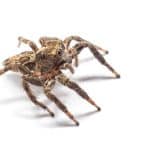
Spiders differ from other arachnids in that they have developed specially adapted chelicerae that sport venom-injecting fangs. In addition to the aforementioned silk-producing spinnerets. These adaptations have allowed spiders to survive and thrive on every continent except Antarctica for more than 200 million years. Thus becoming more specialized and diverse all the while. In that time, spiders have become the seventh most diverse order of organisms on Earth.
Throughout the great State of Missouri, there are only two species of spider that pose any threat to humans: the Brown Recluse, and the Black Widow. The rest, while just as creepy looking, are either incapable of successfully biting people, or, are non-venomous enough that their bites rarely result in anything more than a painful welt. Descriptions of these various spiders can be found below, as well as some of their common behaviors, and a few helpful preventative tips and tricks to keep these creepy crawlers at bay.
![]()
Appearance:
- Stripe Pattern: Wolf spiders typically have two distinct parallel stripes running the length of their cephalothorax (head).
- Eye structure: Wolf spiders have remarkably good eyesight due to their distinctive eye structure. They have two very large main eyes, with a row of four smaller eyes beneath, and two more smaller eyes above.
- Hairy: Wolf spiders are furry in appearance. If a spider appears to be hairless, it probably isn’t a wolf spider.
- Athletic Build: Wolf spiders are built for speed, as evidenced by their large bodies and long, stocky legs. If a spider is small and/or spindly, it most likely isn’t a wolf spider.
Behaviors:
- No Web: While there are exceptions, the vast majority of wolf spider species do not spin webs.
- Weak climber: In the home, wolf spiders are typically seen on ground level, as their physiology makes it difficult for them to climb sheer surfaces. If you see a spider high on the wall or ceiling, it likely is not a wolf spider.
- Babies on board: Female wolf spiders carry their freshly hatched offspring on their back until they are ready to fend for themselves. One female spider can carry up to 200 spiderlings, which will scatter if disturbed.
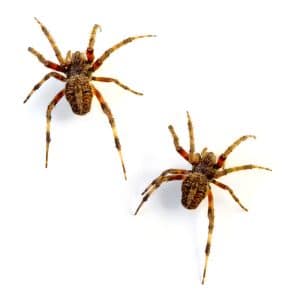 Two of the most common and easily recognizable species among these are the Yellow Garden Spider and the slightly smaller Banded Garden Spider, both of which are named for their strong preference for building their webs in gardens. These garden spiders are sometimes called “writing spiders” due to a unique zigzag pattern that they weave into their webs, called a stabilimentum, but none have ever been observed writing actual words (Sorry, Charlotte’s Web fans).
Two of the most common and easily recognizable species among these are the Yellow Garden Spider and the slightly smaller Banded Garden Spider, both of which are named for their strong preference for building their webs in gardens. These garden spiders are sometimes called “writing spiders” due to a unique zigzag pattern that they weave into their webs, called a stabilimentum, but none have ever been observed writing actual words (Sorry, Charlotte’s Web fans).
Appearance:
- Orb web: Orb weaver spiders’ appearances vary widely from species to species, but the vast majority of them create orb webs, which are the stereotypical circular webs frequently seen under eaves and tree branches. Orb webs belonging to garden spiders will also have a zigzag shape woven into the center of the web.
Behavior:
- Web-surfers: Orb weavers spend nearly their entire life on their webs. They are constantly either tearing down old webs and constructing new ones, or sitting in the middle of the web, monitoring it for prey activity.
- Non-Wandering: As they spend so much time on their webs, Orb Weavers are not usually found crawling from place to place unless they are in the process of constructing a new web.
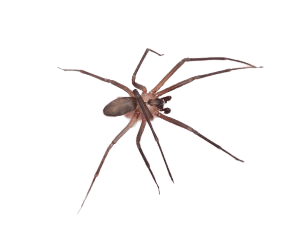 Appearance:
Appearance:
- Violin shape: The most recognizable feature of a brown recluse is the distinct violin/guitar shape on their backs. The base of the violin is over the spider’s eyes, while the neck of the violin points towards the abdomen (rear end) of the spider.
- Coloration: The brown recluse is a uniform mottled brown color, with an abdomen that can range from light to dark brown depending on the spider’s diet. The only variation in color is from the aforementioned violin shape on the spider’s back, which is a darker brown than the rest of the spider.
- Non-hairy/spiny: Brown recluses only have very fine hairs on their body; they are not noticeably fuzzy or spiny, like jumping spiders or wolf spiders.
Behaviors:
- Reclusive: As their name suggests, brown recluses tend to behave reclusively, shying away from high-traffic areas in favor of secluded, hard to reach places. Brown recluses are not typically found out in the open.
- Inconspicuous ‘webs’: Brown recluses do not construct neat, symmetrical webs, such as those you might find under your eaves or between bushes in your yard. Rather, they make their (somewhat messy, asymmetrical) webs in out-of-the-way places. If a spider is seen resting on a “classic” spider web, it is likely not a brown recluse.
- Nocturnal: Brown recluses are inactive during the day, and emerge at night to hunt. If a spider is observed as being active during the day, it is probably not a brown recluse.
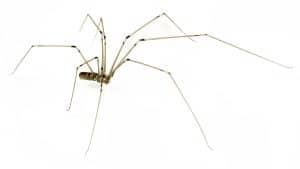 So what’s everyone getting wrong about these supposedly harmless spiders? Well, for starters, Daddy Long-legs are not spiders- they do not have the necessary fangs, venom glands, or silk-producing spinnerets, meaning that they cannot bite or create webs. For that reason, Daddy Long-legs, or Harvestmen, are classified as their own order of arachnids called Opiliones. As they don’t possess the necessary physiology to hunt for prey like spiders do, Harvestmen are largely scavenging omnivores, with a diet consisting of plants & fungus, small insects like aphids, and various dead organisms.
So what’s everyone getting wrong about these supposedly harmless spiders? Well, for starters, Daddy Long-legs are not spiders- they do not have the necessary fangs, venom glands, or silk-producing spinnerets, meaning that they cannot bite or create webs. For that reason, Daddy Long-legs, or Harvestmen, are classified as their own order of arachnids called Opiliones. As they don’t possess the necessary physiology to hunt for prey like spiders do, Harvestmen are largely scavenging omnivores, with a diet consisting of plants & fungus, small insects like aphids, and various dead organisms.
Harvestmen, while somewhat creepy, are harmless, and should not be conflated with spiders. Below are a few telltale behaviors and characteristics of Harvestmen to aid in their identification.
Appearance:
- Long legs: Harvestmen will typically have eight long legs, the longest of which are used as antennae. Harvestmen can detach these legs if they feel threatened or trapped.
- Oval-shaped body: Unlike spiders, which have two visibly distinct body segments, Harvestmen only appear to have one round segment, which composes their whole body. If an arachnid has multiple visible body segments, it is more than likely not a Harvestman.
- Only two eyes: Harvestmen only have two eyes, whereas most spiders have six or eight.
Behavior:
- Sociable: Many species of Harvestmen will cohabitate with other members of their species, sometimes forming groups numbering in the thousands.
Moisture-loving: Harvestmen do not retain moisture well, and as such, can dry out and die rather easily. This is why they prefer to live in shaded, moist places like basements and crawl spaces, as well as under the bark of trees and in piles of leaf litter.
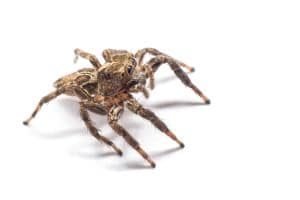 As their name suggests, jumping spiders can jump- remarkably well, in fact. These spiders are capable of jumping distances dozens of times longer than their own body length, all thanks to a handy trick they can do with the blood pressure in their hind legs. Jumping spiders use this trick to get around their environment, as well as to pounce on their prey from afar.
As their name suggests, jumping spiders can jump- remarkably well, in fact. These spiders are capable of jumping distances dozens of times longer than their own body length, all thanks to a handy trick they can do with the blood pressure in their hind legs. Jumping spiders use this trick to get around their environment, as well as to pounce on their prey from afar.
Now, if you’re a football fan, you’ll know that executing a leaping tackle on a moving target can be quite a task, even for professional athletes. So how is it that a spider with a brain the size of a poppy seed can do it with ease? Well… no one knows! Extensive research has shown that jumping spiders have exceptional vision, which allows them to locate their prey and ascertain its distance, but researchers have yet to discern how these spiders manage to employ such dynamic thought processes (calculating trajectory, threat assessment, indirect stalking approach, etc.) with so little available brain matter.
Through their masterful pest hunting practices and human-avoidant lifestyles, jumping spiders have earned the approval, and even affection, of many people. There’s even a growing number of people who keep jumping spiders as pets! This is likely due to jumping spiders’ large, almost expressive eyes, which give them a ‘cuter’ appearance than most spiders. Below is a list of some more physical characteristics of jumping spiders, as well as some of their common behaviors.
Appearance:
- Short & stout: Jumping spiders are not considerably large or spindly spiders. Most are about the size of a dime, with the largest among them growing to about an inch long.
- Big, expressive eyes: Easily their most recognizable feature, jumping spiders have four eyes front and center on their cephalothorax, with the inner eyes being larger than the outer eyes. There are an additional two eyes on either side of cephalothorax. These eight eyes provide the spider with nearly 360 degrees of vision.
- Colorful characters: As jumping spiders are visually-oriented and diurnal, many species have developed bright colorations on their bodies to attract mates.
Behavior:
- Human-avoidant: Jumping spiders are capable of seeing how big people are, and as such, typically do not demonstrate aggression towards humans.
- Pouncing predators: Jumping spiders utilize their exceptional vision in tandem with their jumping abilities to pounce directly on to their prey. They also jump to traverse their environment and to escape threats.
- Outdoors-lovers: Jumping spiders prefer to spend their time outdoors, where they have enhanced access to sources of prey.
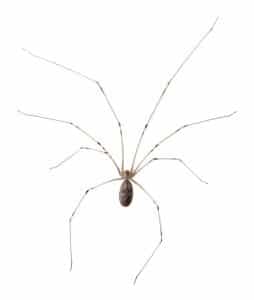 Despite their small and wispy appearance, these spiders are highly effective hunters, and have a propensity to prey upon both insects and fellow spiders alike. Unlike most spiders, Cellar spiders are largely found indoors, as they have adapted specifically to benefit from the conditions inside human dwellings. Some species cannot effectively survive outdoors, and will quickly die if ‘taken outside’.
Despite their small and wispy appearance, these spiders are highly effective hunters, and have a propensity to prey upon both insects and fellow spiders alike. Unlike most spiders, Cellar spiders are largely found indoors, as they have adapted specifically to benefit from the conditions inside human dwellings. Some species cannot effectively survive outdoors, and will quickly die if ‘taken outside’.
There are over 1600 species of cellar spider, all of which sporting distinct appearances and behaviors. Below you can find a short list of their common appearances and characteristics.
Appearance:
- Long-legged: Cellar spiders have very long legs in proportion to their bodies. The joints of these legs are often darker than the rest of the leg, giving them a striped appearance.
- Web-bound: Cellar spiders are most frequently seen on their webs, where they sit in wait of prey. These webs are typically found high on walls, especially in corners and where the ceiling and wall meet.
Behavior:
- Web shakers: If disturbed or threatened while on their web, cellar spiders will vigorously shake the web, causing them to rapidly sway back and forth in the web. This is a defense mechanism that makes the spiders much harder to track to any prospective predators.
Spider Hunters: Cellar spiders commonly prey upon other spiders, such as house spiders, funnel-web spiders, and even some species of widow spiders.
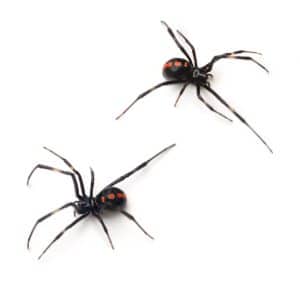 As with many species, male black widows are much smaller than their female counterparts, and as their venom glands are also much smaller, are not dangerous to humans. Female black widows, on the other hand, have very large venom glands, and thus, are dangerous to humans. Bites from female black widows can cause excruciating pain, sweating, vomiting, and muscle stiffness. These symptoms normally last three to six days, but can persist for weeks or months in extreme cases. While there hasn’t been a recorded death from a black widow bite since 1983, life threatening symptoms can occur in very rare cases. If you think you or your pet have been bitten by a black widow, the best course of action is to seek medical attention as soon as possible.
As with many species, male black widows are much smaller than their female counterparts, and as their venom glands are also much smaller, are not dangerous to humans. Female black widows, on the other hand, have very large venom glands, and thus, are dangerous to humans. Bites from female black widows can cause excruciating pain, sweating, vomiting, and muscle stiffness. These symptoms normally last three to six days, but can persist for weeks or months in extreme cases. While there hasn’t been a recorded death from a black widow bite since 1983, life threatening symptoms can occur in very rare cases. If you think you or your pet have been bitten by a black widow, the best course of action is to seek medical attention as soon as possible.
Black widows prefer the outdoors, typically opting to build their webs in semi-sheltered places near ground level, such as wood piles and shrubs. When found in the home, black widows usually reside in dark, less active spaces like garages, crawlspaces, and basements. These spiders will not typically inhabit a residence unless there is an available food source (existing insect population) for them to subsist on.
Appearance
- Black body, red marks: North American black widows all share the same general appearance: a glossy black body coupled with bright red accent coloration on the abdomen, typically in the shape of an hourglass on their underside.
- Messy Webs: Black widows build messy, asymmetrical webs. If you find a spider resting on a classic circular spider web (orb web), it is most likely not a black widow.
Behavior:
- Web-bound: Black widows build their cobwebs in dimly-lit, hard-to-reach places, typically close to the ground. They spend most of their time on these webs, constantly monitoring them for prey activity.
- Fitting namesake: Black widow females tend to cannibalize their mates- hence the name ‘widow’.
- Non-aggressive: Black widows are sedentary and solitary, which means they don’t typically cross paths with humans unless by accident, and even then, typically only bite when feeling threatened.
Today, there are over 51,000 verified species of spider, divided up into 136 families, all of which come with their own unique morphology and behaviors. Wandering spiders, for instance, have developed a preference for actively seeking out prey and chasing it down. Whereas orb-weaver spiders prefer to create ornate webs to trap prey. There are even species that will create lairs with trap doors, which they use to ambush prey. While most spiders are solitary and actively hostile to other spiders, some species of “social spiders” have adapted to form social structures. They can cohabitate in large groups, where they create communal webs and hunt cooperatively.
Regardless of their preferred hunting style, spiders are incredibly effective predators. Some researchers have estimated that spiders kill 400-800 million metric tons of prey every year. That is a staggering 1,208 Empire State Buildings worth of roaches, ants, crickets, beetles, mosquitos, birds, bats, lizards, and mice. It’s hard to imagine what the world would look like without spiders, but one thing is for certain: there would be a LOT more insects crawling around.
Overall, spiders are an instrumental component of nearly every ecosystem on Earth, but have a tendency to overstep boundaries and overstay their welcomes. That’s where All Solutions Pest Control comes in. Our local pest control professionals are well acquainted with the spiders of the Show-Me State, and well equipped with all of the tools and knowledge necessary to help with all your spider needs, guaranteed.
Habits
Prevention and Tips
The best way to prevent spiders from gaining access to your home is by ensuring all access points are well-sealed. Garage doors and sliding glass doors are often poorly sealed, but over time, any door that sees frequent use can form gaps in the door seal. Unsealed wall penetrations, such as those for plumbing or electrical wiring, can also allow spiders access to the home.
Consistent, recurring pest management is the most effective step you can take to reduce any existing spider populations in your home. Comprehensive treatments will directly afflict spider populations, as well as their food sources, effectively denying the spiders a source of sustenance. These combined effects will drastically reduce the number of spiders in your home.
The best way to avoid spiders coming in is by keeping the immediate vicinity of the house clear of any debris or detritus, such as piles of wood or yard waste. Shrubs and bushes should also be trimmed, leaving a gap between the house exterior and the plants.
Get a Free Estimate!
Request A Quote Today
...
Contact Us
Location :
44 Jason Ct, St Charles, MO 63304